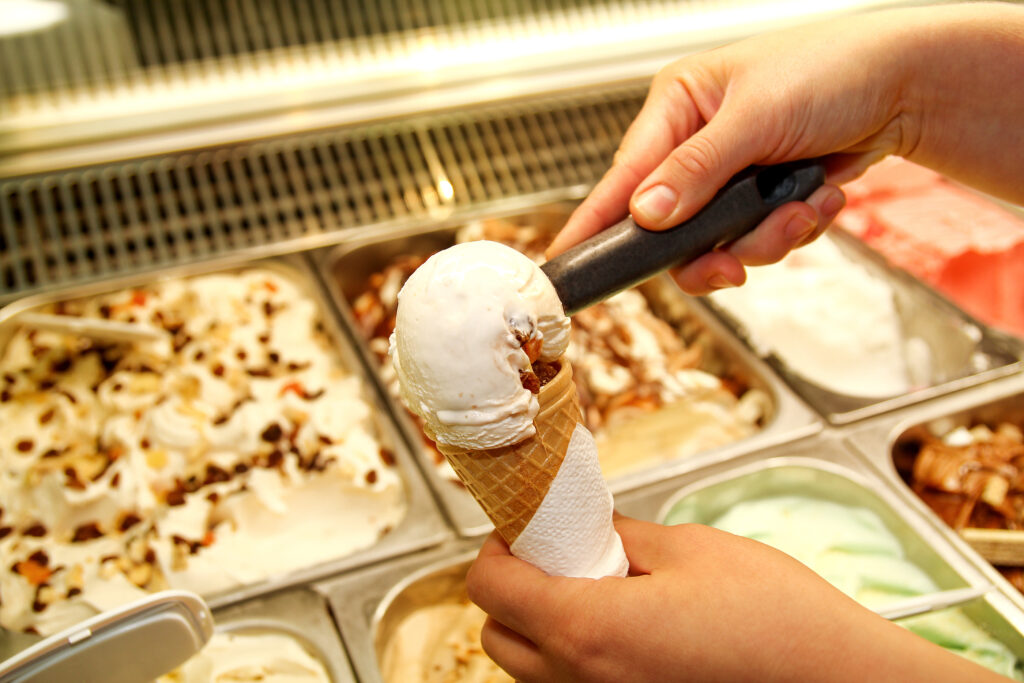
What are the key ingredients for a successful ice cream store in the 2020s? According to IBISWorld’s report Ice Cream Stores in Australia (October 2021) there are a number of factors at play.
Delivering the goods
Lockdowns heralded the end of the ice-cream queue but brands were quick to scoop out a fresh way to keep revenue. Customers who were once concerned about product remaining fresh and frozen with a delivery service relished the chance to stay home and wait for their favourite flavours to land on their doorstep. Pick up and delivery options have helped retailers retain revenue through 2020/21.
Diversification in distribution over the past five years has also meant brands like Ben & Jerry’s selling their take-home tubs in supermarkets.
A rising health consciousness and a taste for superior product have been driving the market. Gelato, for instance, has higher profit margins and is difficult to re-create at home. Swapping to a cheaper alternative isn’t an option for premium-product customers, and that has helped maintain the market.
Key statistics
- Revenue $404.7 million
- 1.3% annual growth 2022-27
- 1.7% annual growth 2022-27
What we’re eating
- Gelato 13.5%
- Sorbet 9.5%
- Soft-serve ice cream 16.2%
- Hard-serve ice cream 31.3%
- Yoghurt products 12.4%
- Other products 17.1% [hot dogs, pancakes, waffles, milkshakes, thick shakes, smoothies, soft drinks, slushies, coffee and tea].
What will influence the market’s growth?
- A rise in household discretionary income
- Health consciousness
- Domestic milk and sugar prices
What’s constraining the market?
- Rising health consciousness
- Competition from gelato and frozen yoghurt stores
- Increasing competition as small operators join the market
- Increased competition from businesses like McDonald’s offering soft-serve
- Downward pressure from ingredients costs
Franchising scoops the market
The author of the IBISWorld report, Suzy Oo, writes that franchisees “benefit from strong branding, consistent advertising campaigns and operational support. The four largest players, all of which have extensive franchising networks, are expected to account for over 30% of industry revenue in 2021-22.”
High franchising fees, standardisation, rising competition and rental costs have proved challenging for franchisees who have seen low profitability. Brands have suffered some store closures.
“Supatreats (Wendy’s Milk Bar), Baskin-Robbins and Franchised Food Company (Cold Rock Ice Creamery and Trampoline) have all lost market shares over the period,” Suzy writes.
In contrast, she says, some franchisers have benefited from a rising demand for premium gelato products.
Stan Gordon, who heads up Franchise Food Company, disagrees that Cold Rock has lost market share, saying that despite Covid-19 corrections, the business has grown over the past few years.
“While the increase in the health-focused market has come with its learning curves, there is still a strong focus on having ‘cheat days’ and treating yourself, which is exactly what Cold Rock [provides]. We are heavily guided by our loyal customers and see the increase in the health-focused market as a way for us to reimagine what’s possible at Cold Rock,” he says.
Aussie gelato chain Gelatissimo’s experience reflects Suzy’s comments that gelato is an increasingly popular premium product.
CEO Filipe Barbosa says, “Gelato consumption continues to grow across all channels, which is great for our industry,” he says. “Consumers have really developed a love for great gelato, which has given rise to a higher level of expectation from all players in our space.”
It’s the premiumisation that’s helped global brand Baskin-Robbins buck the trend with four years of strong double-digit comparable sales growth, general manager Julian Casa says.
“Despite IBISWorld’s speculation, the brand has achieved industry recognition, excelling in the execution of innovative marketing campaigns and immersive digital experiences, and recorded its most successful promotional campaign in recent history,” he says.
Julian also points to early adoption and leadership in online food delivery, compelling new product innovation and strategic brand partnerships as indicators of the brand’s position in the marketplace.

